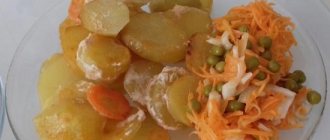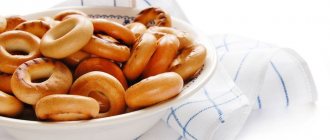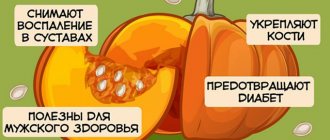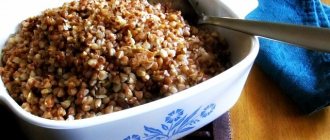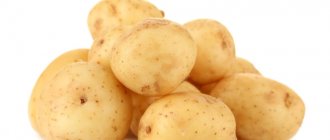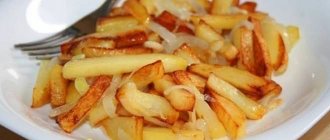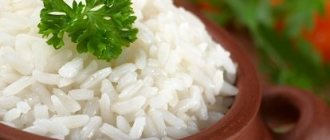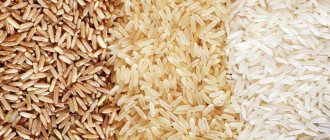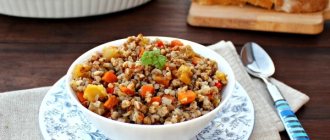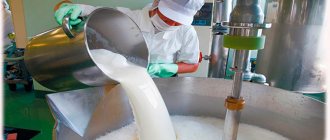Chips are the most common fast food in the world. The appetizer is made from thin slices of potatoes; other vegetables such as sweet potatoes, beets or carrots are less often used. Slices of root vegetables are deep-fried, removed from excess fat and packaged in bright, rustling packages. The global potato chip market is worth tens of billions of dollars a year. The product accounts for about 40% of the total US snack food purchases. Crispy slices have become a real gastronomic giant and have not slowed down for several years.
What do you need to know about chips, how are they produced, and can the product really lead to obesity [1]?
Banana chips: calorie content per 100 grams, nutritional value, composition
Calorie content of banana chips per 100 grams is 517 kcal. 100 g of product contains:
- proteins – 2.2 g;
- fats – 33.4 g;
- carbohydrates – 51 g.
Read: Calorie content of shrimp per 100 grams
To prepare the snack you need the following ingredients:
- fresh bananas;
- sugar syrup;
- vegetable oil;
- honey.
Banana Chips Recipe:
- bananas cut into thin slices are fried in a frying pan in oil;
- fried slices are dipped in boiled honey-sugar syrup;
- The chips are allowed to dry. The dish is ready!
Historical reference
History claims that the appearance of chips was nothing more than an accident. It all happened on August 25, 1882 [2][3]. George Crum worked as a chef at Moon's Lake Lodge in the American resort of Saratoga Springs. The warm August day was no different from a series of others. At the end of dinner, the waiter ran into the kitchen and ordered the dish to be remade. Railroad magnate Cornelius Vanderbilt didn't like fried potatoes. The tycoon complained that the vegetable was cut into pieces, and he did not even want to see such thick potatoes.
Content:
- Historical reference
- How chips are prepared on an industrial scale
- Harm and side effects from use
- Is there an alternative to chips?
Crum decided to play a trick on Vanderbilt and cut the potatoes no thicker than a paper sheet, fried them and sent them to the hall. A few minutes later the waiter ran into the kitchen again. He said guests love it and want a daily serving of thinly sliced potatoes for dinner. Kram did not expect such a reaction, but quickly got his bearings and made the dish the highlight of the restaurant. This is how “Saratoga Chips” appeared on the menu, which from a signature dish of a cozy restaurant turned into the most popular snack in the world. In 1860, the chef opened his own restaurant, which was destined to last only 30 years. On each table of the establishment there was a compliment from the chef - a basket with those same potato chips. Crum's establishment quickly gained popularity and became a fashionable restaurant for wealthy Americans and tourists. George sold fried slices only inside the restaurant, without providing take-out bags of the product. But competitors took advantage of this tactic, and chips flooded the city streets.
In 1895, William Tappendon opened his own potato slice production. William started the business in his own kitchen, and later, through titanic efforts, built a factory and launched industrial production. The first shipments were delivered to Cleveland.
A few years later, Laura Scudder would introduce wax paper for packing potatoes. This is how the concept of chip bags was born. And in 1932, the Lay's brand appeared. This is the first national brand of chips that has survived to this day and has not lost its leadership in the modern market.
The new trend captured not only America, but also the Soviet Union. The first chips in the USSR were released in 1963. “Crispy Moscow potato slices” created a sensation among the population. The first factory for the production of the product was located in Moscow. Later they spread throughout all the union republics.
Potato chips Lays with salt: calorie content per 100 grams, nutritional value, composition
Calorie content of Lays chips per 100 grams is 510 kcal. 100 g of product contains:
- proteins – 6 g;
- fats – 31 g;
- carbohydrates – 52 g.
Despite the fact that Lays chips are made from natural potatoes, the product is not considered healthy. During heat treatment, potatoes lose almost all vitamins and minerals, while they are saturated with oils, flavor enhancers, harmful flavoring additives, and flavorings that contribute to the rapid gain of extra pounds and disruptions in the gastrointestinal tract.
The composition of Lace chips with salt includes potatoes, vegetable oil, and salt.
9.What errors can there be?
Everyone can make a mistake. But when choosing a profession, this must be excluded. After all, you are making a decision on which your future life will depend.
I want to suggest some rules and tips that you can follow to avoid mistakes in this area:
Understand yourself! Establish your abilities, talents, physical and moral capabilities. Take into account the material aspect - whether the family can provide the desired education. When choosing your profession, find out your strengths and weaknesses in relation to it. Contact a psychologist for professional advice. You can take the test electronically or on paper. And get a detailed answer. Based on the test results, understand in detail the proposed professions. Maybe there is one you didn’t know about. But she's quite interesting. It will be useful if you know people who have a profession that you like. You will be able to learn all the intricacies and costs of work, and get advice. Having decided on a profession, select a university for studying
Pay attention to alumni reviews. Find out the required set of Unified State Examinations for admission
Prepare well for passing the Unified State Exam. Try to score the maximum number of points. Pass the entrance examination to your chosen university. Get your dream profession and enjoy your profession. Move quickly up the career ladder.
Lavash chips: calorie content per 100 grams, bju, recipe
Calorie content of lavash chips in the oven per 100 grams is 328 kcal. 100 g of dish contains:
- proteins – 7.1 g;
- fats – 25.9 g;
- carbohydrates – 17.4 g.
Read: Calorie content of butter 82.5%
To make lavash chips you will need:
- 0.13 kg of Armenian lavash;
- 0.15 kg of 20 percent sour cream;
- 50 g sunflower oil;
- 50 g hard cheese;
- black pepper and salt to taste.
Lavash chips recipe:
- Armenian lavash is laid out on the table and thoroughly coated with sour cream;
- grate hard cheese on top, add black pepper and salt to taste;
- Lavash is cut into pieces, lightly sprinkled with sunflower oil on top, baked in the oven at 200°C until golden brown.
Pringles chips: calorie content per 100 grams, nutritional value, composition
Calorie content of Pringles chips with paprika per 100 grams is 503 kcal. 100 g of snack contains:
- proteins – 4.7 g;
- fats – 31 g;
- carbohydrates – 52 g.
Nutritionists and doctors recommend against eating Pringles chips because they contain a lot of fat, starch, food additives and dyes. The product is contraindicated for diseases of the gastrointestinal tract, kidneys, liver, excess weight, high cholesterol, heart and vascular diseases.
The ingredients of Pringles Paprika Chips include dehydrated potatoes, vegetable oils, rice flour, wheat starch, paprika flavor, emulsifier, maltodextrin, salt.
Taste and crunch
There were no comments regarding organoleptics. All the chips turned out to have the taste and smell characteristic of this type of product, and all were crispy. The contents of “scrap”—broken slices—were also studied.
Air - for protection
Many people mistake “inflated” packs with a handful of chips for downsizing - a marketing technique when a product is reduced without reducing the packaging. The buyer thinks there are more chips inside than there really are and is more willing to pay. But no. Such packaging is not needed at all in order to deceive the buyer, but in order to protect fragile slices during transportation. The air in the packs is nitrogen, which serves as a safety cushion and at the same time protects products from premature spoilage.
On average, crumbs accounted for 5–10% of the contents of the pack. Not a single piece of scrap was found in the Pomsticks chips. The most broken chips - a third of the pack - are in the Moscow Potato chips. Most likely, this is due to the transportation and storage conditions of products in retail chains.
Corn chips Nachos: calorie content per 100 grams, nutritional value, composition
Calorie content of Nachos corn chips per 100 grams is 500 kcal. 100 g of snack contains:
- proteins – 7 g;
- fats – 25 g;
- carbohydrates – 61 g.
Corn chips are considered healthier than potato chips, but it is also recommended to eat them rarely and in small quantities. The large amount of calories, carbohydrates and fat makes chips a prohibited product for overweight people, weight loss and dieting.
The composition of Nachos corn chips with cheese flavor includes corn grain, water, vegetable oil, and the Cheese flavoring additive.
Conclusion
That's what one Snickers at lunchtime or a bottle of beer in front of the TV in the evening costs us. When we consume hundreds of unnecessary calories every day, we don't think about how much effort we have to put in just to work them off. Of course, people who are blessed with a fast metabolism will now laugh in my face. But I also know that there are many people who cannot afford such dietary indulgences.
Now you know what one food item costs you. Do you think about such things? Or do you think that such mathematics is unnecessary?
Chips first appeared in the middle of the 19th century and very quickly won the love of all segments of the population in many countries, and the oldest brand of the product that still exists today is the Lays brand. Over more than a century and a half of history, the product has not undergone major changes in the method of preparation - it is still very thin slices of potatoes fried in a large amount of oil. But new, sometimes very non-standard, flavor combinations are released almost every month. Over time, not only potato and corn chips gained popularity, but also healthier ones - apple, banana, orange, etc. In this article we will talk about the calorie content of different types of chips.
Potato chips are harmful
The following harms of potato chips have been proven:
- Regular consumption of the product provokes obesity and a slowdown in metabolic processes in the body;
- potato chips cause diabetes mellitus and disrupt the functioning of the pancreas;
- the snack contributes to the development of ulcers, disrupts the functioning of the heart, and leads to problems with the vascular system;
- harmful fats in chips stimulate the occurrence of cancer;
- Constant consumption of potato chips causes harm to men's health, including a decrease in testosterone levels in a man's body, impaired reproductive function, and decreased sperm quality;
- Fatty acids in chips disrupt the functioning of the nervous system and reduce the body’s immune functions.
What was discovered?
- Cadmium and arsenic.
These potentially dangerous substances have been found in potato and beet chips. According to TR CU 021/2011, cadmium is allowed in products in an amount of no more than 0.03 mg/kg, arsenic - no more than 0.2 mg/kg.
Cadmium was detected in four brands of potato chips: Pomsticks (0.31 mg/kg), Lorenz (0.13 mg/kg), Moscow Potato (0.064 mg/kg), Kracks (0.061 mg/kg). The cadmium content is maximum in Pomsticks chips; it exceeds the maximum permissible level by 10 times.
Both cadmium and arsenic were detected in Zdoroveda beet chips. The content of cadmium (0.18 mg/kg) and arsenic (3.48 mg/kg) exceeds the maximum permissible level by 6 and 17.4 times, respectively.
For information
Cadmium, a heavy metal, belongs to the second hazard class and has a pronounced tendency to accumulate in the body. It accumulates mainly in the liver and kidneys, also in the tubular bones, pancreas, and spleen. Its half-life from the body ranges from 10 to 30 years. When a certain concentration is reached, cadmium can cause severe dysfunction. Heavy metal enters plants from the soil, with water and nutrients. Some soils are initially characterized by a high content of cadmium, others are contaminated with industrial waste or treated with fertilizers containing cadmium.
Manufacturers of goods containing cadmium consider the standards of TR CU 021/2011 to be imperfect. This technical regulation does not establish separate standards for chips.
Commented by Vladimir Goldshtein, head of the department for processing starch-containing raw materials of the All-Russian Scientific Research Institute of Starch Products, a branch of the Federal State Budgetary Institution Federal Scientific Center for Food Systems named after. V. M. Gorbatov" RAS, Ph.D.
:
– Mercury, cadmium, lead and arsenic are metals that exhibit highly toxicological properties at very low concentrations and do not perform any beneficial function. They are neither vital nor beneficial, but even in small doses they lead to disruption of the body's normal metabolic functions.
Arsenic is found in almost all plant and animal foods, as well as in water.
High cadmium content is typical for clay and sandy soils. In addition, it enters the soil as a technogenic pollutant due to emissions from metallurgical enterprises, thermal power plants, and agricultural fertilizers: phosphates and nitrates.
Lead, cadmium and arsenic found in local soils can accumulate in edible plant parts. Food products, including chips, must comply with the documents: “Maximum permissible concentrations of heavy metals and arsenic in food raw materials and food products” (approved by the Chief State Sanitary Doctor of the USSR on March 31, 1986, No. 4089-86) and the Technical Regulations of the Customs Union TR CU 021/2011 “On food safety”.
Exceeding the concentrations of heavy metals by 6, 10 and 17 times should lead to a ban on the sale of products and their destruction as dangerous.
- Ochratoxin A.
Identified in Carambas corn chips in an amount of 0.017 mg/kg, which is three times higher than the standards established for raw materials (corn flour). However, this is not considered a violation, since the standards of TR CU 021/2011, unfortunately, do not yet apply to chips. According to TR CU 021/2011, corn flour (the raw material from which corn chips are made) may contain no more than 0.005 mg/kg of ochratoxin A.
For information
Ochratoxin A is the most toxic mycotoxin of the ochratoxin species. It can appear in food products during the cultivation of raw materials, their harvesting, and storage. During the production of the finished product, its storage or transportation - in cases where conditions for fungal infection arise. Most likely, the grain was not tested for the presence of mycotoxins upon receipt.
- Acrylamide
. At the moment, the content of this carcinogenic substance in products, formed during frying, is standardized only by European Union documents - Commission Regulation (EU) 2017/2158 of November 20, 2017 - no more than 750 mcg/kg. A relatively high amount of acrylamide was detected in one of the 16 products - Moscow Potato potato chips: 1360 mg/kg of acrylamide, which is almost twice the European standards.
Lyudmila Buslaeva
Director of the Research Department of Roskachestvo
– Acrylamide is formed mainly in foods that undergo high heat treatment. Acrylamide has been present in food for a long time, ever since humans began to heat food, but it became known only in 2002. It was then that a group of European scientists published the results of a study that revealed the presence of acrylamide in some baked and fried foods. European scientists have conducted studies that have revealed that too high concentrations of acrylamide can affect health and have a carcinogenic effect - usually on the reproductive organs.
Read more about which products form acrylamide and what measures are being taken to reduce its amount HERE
.
Mariyat Mukhina
nutritionist, doctor of medical sciences
– Unfortunately, chips are cheap, and many people eat them uncontrollably in large quantities. Meanwhile, this is a carcinogenic product that provokes the development of tumors and can increase the risk of cancer. In America, stick-shaped chips are jokingly called “cancer sticks.” Let me remind you that in men after 45 years of age, the risk of developing intestinal cancer and the formation of polyps increases. Therefore, for those who have reached this age, chips should be prohibited.
What other foods are not very healthy for men? Read HERE
.
- KMAFAnM
. In general, the microbiology of the chips is in order: none of the tested samples contained Escherichia coli bacteria, Staphylococcus aureus, yeast or mold. But an excess of QMAFAnM was found in Kracks potato chips - 1.1 × 10^3 CFU in 1 gram of product, despite the fact that TR CU 021/2011 dictates the total microbial contamination of no more than 1 × 10^3 CFU in 1 gram.
Vladimir Goldstein
explains:
– Exceeding QMAFAnM may be due to biological contamination of indoor air, various microorganisms in the packaging compartment, or biological contamination of food additives applied to chips. The chips are hermetically sealed, so storage conditions cannot affect the condition of the packaging. And food additives can be contaminated during their production or storage.
- Pesticides
. Chips were tested for 420 pesticides. Four pesticides were detected in trace amounts. Chlorprofam – in 9 TMs, imidacloprid – in 2 TMs, propamocarb – in 2 TMs and pirimifos-methyl – in 2 TMs. Of these, the content of traces of only one of the listed pesticides was detected in nine brands, and two types of pesticides were detected in chips from three brands. Pesticides could only get into the chips through the main raw materials - root vegetables and cereals.
There is not a trace of pesticide in only four brands out of the 16 studied - Santa Maria and Carambas corn chips, Kiwa beet chips, and Pringles potato chips.
In the Russian Federation, the content of pesticide residues in food products is regulated by GN 1.2.1323-03 “Hygienic standards for the maintenance of environmental objects (list)”. The main provisions of supervision, based on the current legislative and regulatory legal acts of the Russian Federation, including Federal Law dated January 2, 2000 No. 29-FZ “On the quality and safety of food products,” are set out in SanPiN 2.3.2.1078-01 “Hygienic requirements for safety and nutritional value food products."
For information
Chlorprofam is a growth inhibitor. It is used to prevent sprouts from sprouting on harvested potatoes. Pirimiphos-methyl and imidacloprid are insecticides against insects and traces of them are often present in grain. Propamocarb is a fungicide used to combat diseases of the soil, roots, and leaves.
- Flavor enhancers.
All detected taste enhancers are safe for human health and are within the legally permitted range (TR CU 029/2012), but some of them are not indicated in the labeling. In particular, these are glutamates (E620 – E625), well known to consumers, as well as lesser known guanylates (E626 – E629), inosinates (E630 – E633) and adenosine monophosphate salts (E634 – E635).
Let's consider this situation in more detail.
During the analysis, glutamic acid, guanylates, inosine, and adenosine monophosphate were detected. In many cases, only one or two flavor enhancers out of three or four identified in the product were indicated on the label, or even not indicated at all. Why? Because the presence of unspecified substances may be due not only to the possible addition of their salts in the form of food additives, but also to their natural content in the product.
According to TR CU 022/2011, the manufacturer indicates only what he adds. And what is naturally present does not need to be indicated.
Vladimir Bessonov
Doctor of Biological Sciences, Head of the Laboratory of Food Chemistry of the Federal State Budgetary Institution "Federal Research Center for Nutrition and Biotechnology":
– You can recognize whether a flavor enhancer has been added to a product indirectly, by one sign – the content of this flavor enhancer is much higher than the others. But this is also an exclusively logical conclusion. In scientific works, in particular in “Methods of biochemistry and cytochemistry of plant nucleic acids”, the natural content of enhancers is allowed in dry samples from 2 to 100 mg/kg, in fresh (non-dehydrated) - from 10 to 250 mg/kg.
Important
The total content of enhancers (guanylates, inosinates and adenosine monophosphate) in the products, judging by the laboratory results, varies between 50–100 mg/kg, which is well within the range of the native presence of enhancers in the product.
Let's summarize. Flavor enhancers were identified in each of the studied samples. However, their content is extremely small, and in cases where they are not listed on the label, we can only talk about the natural presence of these substances.
There are no excesses relative to the standards. The total permissible amount is no more than 500 mg/kg, according to the “Hygienic standards for the use of flavor and aroma enhancers”, Appendix 16 to the technical regulations “Safety requirements for food additives, flavorings and technological aids” (TR CU 029/2012) “Hygienic standards. Application of flavor and aroma enhancers."
Vladimir Bessonov comments
:
– In a situation where a product contains substances only inherent to this product, even if they can be called food additives, there are no violations. Guanylates and inosinates, adenosine monophosphate are natural substances. They are present in all living organisms (both animals and plants). I repeat once again, they are endogenous, that is, they are synthesized in any organism that has DNA and RNA. This is their normal content in a biological object; they are not added there. They are contained there natively, by nature. In this situation, the listed components formed independently in the product. If you conduct a broader study, then in chips you can find acetates, and mono- and diglycerides of fatty acids, which are simply normal components of food products, but they also have analogues among food additives. Just once again this proves that a food product is a complex mixture of chemicals that are studied by food chemistry. Of course, amplifiers can be produced synthetically and added, but this is expensive. If a substance (or ingredient) is added to a product by the manufacturer, only then is it included in the labeling.
Are the identified flavor enhancers safe?
– The safety of flavor enhancers such as guanylates and inosinates was reviewed by the Joint FAO/WHO Expert Committee on Food Additives (JECFA) from 1974 to 1992. For these food additives, the maximum daily intake has not been established, says Bessonov
. – This means that they do not cause harm to health.
Can't eat that much
The negative impact on health has been proven at a dosage of about 700 grams per day for a person weighing 70 kg. A person simply cannot eat that much amplifier in its pure form every day.
– The claim that taste enhancers are addictive is unproven. Apart from the statements of bloggers and illiterate doctors, there is no scientific basis for this. To say that an enhancer is addictive is to talk about addiction to food in general, since food always contains taste enhancers, adds Vladimir Bessonov
. – Products without inosinates are pure sugar, for example, pure starch, pure refined deodorized fat... We eat them, of course, but they are not the basis of our diet. You won't just eat them. All other products contain enhancers natively; their presence is determined by the biology of animals and plants.
Why then do chips have such a rich taste and aroma?
– The technology for producing chips itself involves some kind of design. Remember your personal experience: protein products (for example, low-fat cottage cheese) and carbohydrate products (for example, sugar) have a very poor taste. Oddly enough, the taste of the product is most often associated with fat, says Vladimir Bessonov
. – In fried potatoes, the main components are potatoes and fat; chips contain even more fat than fried potatoes. Fattier foods are always more attractive and tastier, and this is not due to flavor enhancers. And we are discussing only “pure” taste. And the chips also use technological flavorings; they replicate the tastes of products that are very attractive from an organoleptic point of view (sour cream, cheese, ham, bacon, fried chicken, etc.).
Read about how flavors are produced and why you shouldn’t be afraid of them HERE
.
“In addition,” notes Vladimir Bessonov
, – manufacturers will not add enhancers to the recipe in larger quantities than necessary, as this will spoil the taste of the product. Chips are a common snack; there is no need to worry about problems from the listed food additives. Other characteristics of chips that should be of much greater concern are their high calorie content and sodium content.
